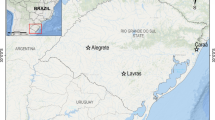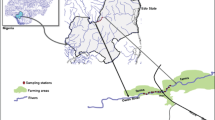Endosulfan is an organochlorine insecticide, consisting of a mixture of two isomers: alpha and beta endosulfan. Endosulfan residues were determined in livers and gills of carp exposed to lethal and sublethal concentrations of endosulfan. The fish which were exposed to a lethal concentration contained the highest residue level in both liver and gills. In carp liver, the percentage of beta endosulfan in the residue decreased with time between exposure and collection of samples whereas the percentage of endosulfan sulphate increased. Carp killed by exposure to endosulfan had a significantly greater ratio of beta to alpha endosulfan and a significantly greater percentage of beta endosulfan in their livers. There was no such clear relationship for the residue composition in fish gills. The determination of residue composition, in particular the percentage of beta endosulfan or the ratio of beta to alpha isomers is recommended in investigations of fish kills when endosulfan is a suspected cause.
Similar content being viewed by others
References
Ariens, E.J., Wuis, E.W. and Veringa, E.J. (1988) Stereoselectivity of bioactive xenobiotics. A pre-Pasteur attitude in medical chemistry, pharmacokinetics and clinical pharmacology. Biochem. Pharmacol. 37, 9–18.
Beyers, R.A., Woodham, D.W. and Bowman, M.C.G. (1965) Residues on coastal bermuda grass, trash and soil treated with endosulfan. J. Econ. Entomol. 58, 160–1.
Caldwell, J. (1990) Metabolic and kinetic criteria in the development of chiral drugs. In Volans, G.N., Sims, J., Sullivan, F.M. and Turner, P. eds. Basic science in toxicology, pp. 79–90. Taylor & Francis, London.
Colton, R.T. and Cutting, F.W. (1985) Cotton Pesticide Guide 1985–1986. Department of Agriculture, New South Wales.
Dorough, H.W., Huhtanen, K., Marshall, T.C. and Bryant, H.E. (1978) Fate of endosulfan in rats and toxicological considerations of apolar metabolites. Pestic. Biochem. Physiol. 8, 241–52.
Goebel, H., Gorbach, S., Knauf, W., Rimpau, R.H. and Huttenbach, H. (1982) Properties, effects, residues and analytics of the insecticide endosulfan. Residue Rev. 83, 1–174.
Herzberg, A.M. (1986) Accumulation and toxicity of endosulfan in the common carp (Cyprinus carpio) and Saint Peter's fish (Orechromis aureus). Bamigdeh Q. Aquacul. Israel 38, 99–107.
Matthiessen, P., Fox, P.J., Douthwaite, R.J. and Wood, A.B. (1982) Accumulation of endosulfan residues in fish and their predators after aerial spraying for the control of tsetse fly in Botswana. Pestic. Sci. 13, 39–48.
Nowak, B. (1990) Residues of endosulfan in the livers of wild catfish from a cotton growing area. Environ. Monitor. Assess. 14, 347–51.
Nowak, B. (1992) Experimental investigation of endosulfan residues in tissues of catfish (Tandanus tandanus). In Miskiewicz, A.G. ed, Proceedings of a Bioaccumulation Workshop: assessment of the distribution, impacts and bioaccumulation of contaminants in aquatic environments, pp. 213–24. Water Board and Australian Marine Sciences Association Inc., Sydney.
Nowak, B. and Julli, M. (1991) Residues of endosulfan in wild fish from cotton growing areas in New South Wales, Australia. Toxicol. Environ. Chem. 33, 151–67.
Phillips, D.J.H. (1980) Quantitative Aquatic Biological Indicators-Their Use to Monitor Trace Metal and Organochlorine Pollution. Applied Science Publishers Ltd, London.
Pick, F.E., de Beer, P.R. and van Dyk, L.P. (1981) Organochlorine insecticide residues in birds and fish from the Transvaal, South Africa. Chemosphere 10, 1243–51.
Shaw, G.R. and Connell, D.W. (1984) Physicochemical properties controlling polychlorinated biphenyl (PCB) concentrations in aquatic organisms. Environ. Sci. Technol. 18, 18–23.
Underwood, A.J. (1981) Techniques of analysis of variance in experimental marine biology and ecology. Oceanogr. Mar. Biol. Ann. Rev. 19, 513–605.
Author information
Authors and Affiliations
Rights and permissions
About this article
Cite this article
Nowak, B., Goodsell, A. & Julli, M. Residues of endosulfan in carp as an indicator of exposure conditions. Ecotoxicology 4, 363–371 (1995). https://doi.org/10.1007/BF00118871
Received:
Accepted:
Issue Date:
DOI: https://doi.org/10.1007/BF00118871




